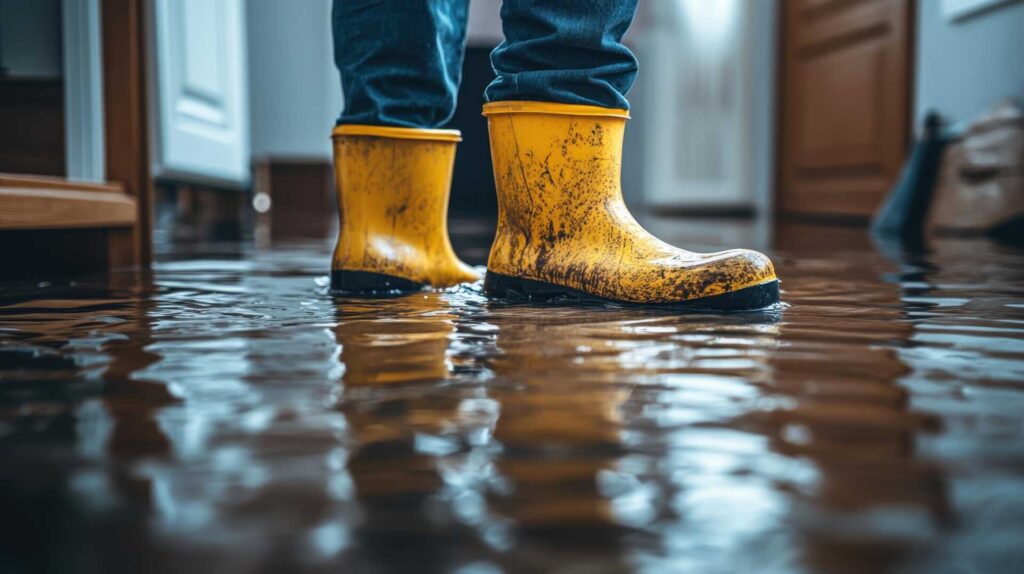
Contents
When dealing with flood damage, you need to focus on three critical restoration techniques. First, efficient water extraction is crucial to minimize the extent of damage. Next, thorough drying and dehumidification ensure that moisture doesn’t linger on your property. Finally, mold prevention is imperative to safeguard against future infestations. Understanding how to implement these techniques effectively can make all the difference in restoring your space. Let’s explore each step in detail.
Key Takeaways
Water Extraction: Quickly remove standing water using submersible pumps and industrial vacuums to minimize damage and prevent mold growth.
Drying and Dehumidification: Employ high-powered fans and dehumidifiers to ensure thorough drying and maintain humidity levels below 60%.
Mold Prevention: Scrub surfaces with antifungal solutions and remove porous materials to prevent mold growth within 24 to 48 hours.
Professional Assistance: Engage flood restoration professionals for expert assessment and advanced techniques to ensure comprehensive recovery.
Regular Maintenance: Conduct routine inspections for moisture and leaks to prevent future flooding issues and safeguard your home.
Water Extraction and Removal
Water extraction and removal is a critical first step in flood restoration, and it requires swift action to minimize damage. You’ll want to assess the affected area quickly, as standing water can lead to structural issues and mold growth.
Utilize effective water extraction techniques, such as submersible pumps and industrial wet vacuums, to remove the water efficiently. Start by clearing debris to access the most flooded areas. Make sure you’re equipped with personal protective equipment (PPE) to safeguard against contaminants.
After extracting water, focus on identifying and addressing any hidden pockets of moisture to prevent secondary damage. Employing advanced removal techniques, such as truck-mounted extraction units, can expedite the process.
Collaborate with professionals who understand the nuances of flood recovery, reinforcing your commitment to a thorough restoration. By prioritizing water extraction, you set the foundation for a successful recovery and protect your space from further complications.
Drying and Dehumidification
After successfully extracting the water, the next phase focuses on drying and dehumidification to eliminate residual moisture and prevent mold growth.
You’ll want to employ high-powered fans and dehumidifiers to enhance air circulation throughout the affected area. This is essential for effective moisture control, as stagnant air can lead to lingering dampness.
Position fans to create a cross-ventilation effect, directing airflow toward wet surfaces. Dehumidifiers should be strategically placed to draw moisture from the air, further speeding up the drying process.
Monitor humidity levels with a hygrometer, aiming to maintain a relative humidity below 60%.
Regularly check surfaces for moisture, ensuring thorough drying of materials like drywall and carpets. This methodical approach helps safeguard your home from future problems, fostering a safe and healthy environment for you and your family.
Mold Prevention and Remediation
Mold can develop within 24 to 48 hours in damp environments, making prompt prevention and remediation critical in flood restoration. To effectively combat mold growth, start by thoroughly drying the affected areas.
Use industrial fans and dehumidifiers to lower humidity levels, ensuring surfaces reach a moisture content below 14%.
Next, utilize remediation methods that include HEPA vacuuming and scrubbing surfaces with antifungal solutions. Always wear protective gear to safeguard against spores.
For porous materials that can’t be cleaned, like carpets or drywall, consider removal to prevent future infestations.
Additionally, apply mold inhibitors to surfaces post-remediation to further reduce risk.
Regularly inspect your space for moisture and leaks, as ongoing vigilance is essential for long-term mold prevention.
Review
When facing flood damage, remember that swift action is your best ally. By efficiently extracting water, thoroughly drying the area, and proactively preventing mold, you’re not just restoring your property—you’re fortifying it against future threats. Think of these techniques as the three pillars of flood restoration; without one, the structure weakens. Stay vigilant and implement these strategies to ensure your home remains a safe haven, even in the wake of nature’s fury.
Recent Posts
Top Techniques for Effective Flood Water Restoration
When faced with a flood, understanding effective floodwater restoration techniques becomes critical. From evaluating damage
Top Techniques for Flood Water Damage Restoration
When dealing with flood water damage, you need a systematic approach to restore your property
